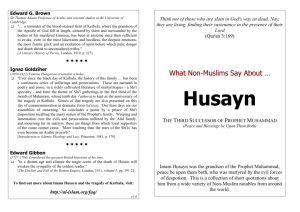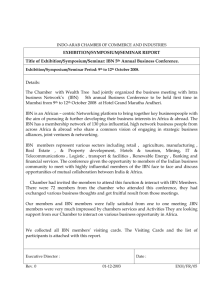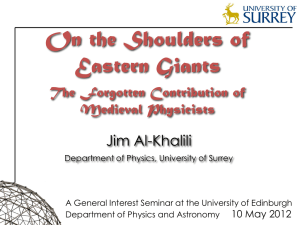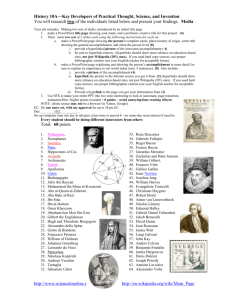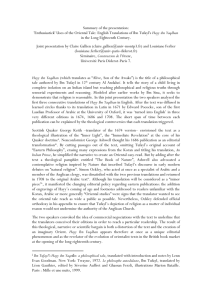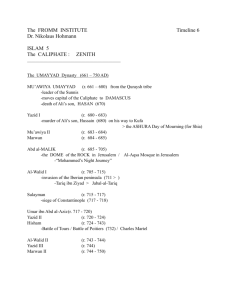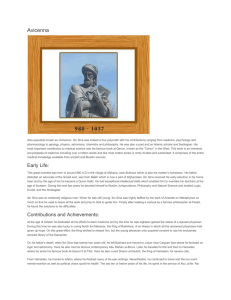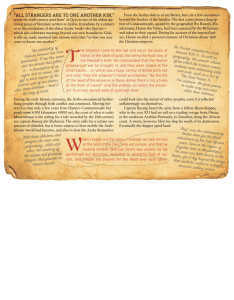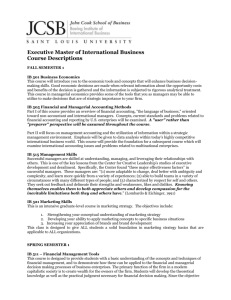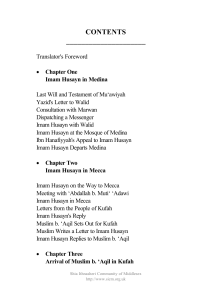Yazid and Husayn - The Islamic History Corner
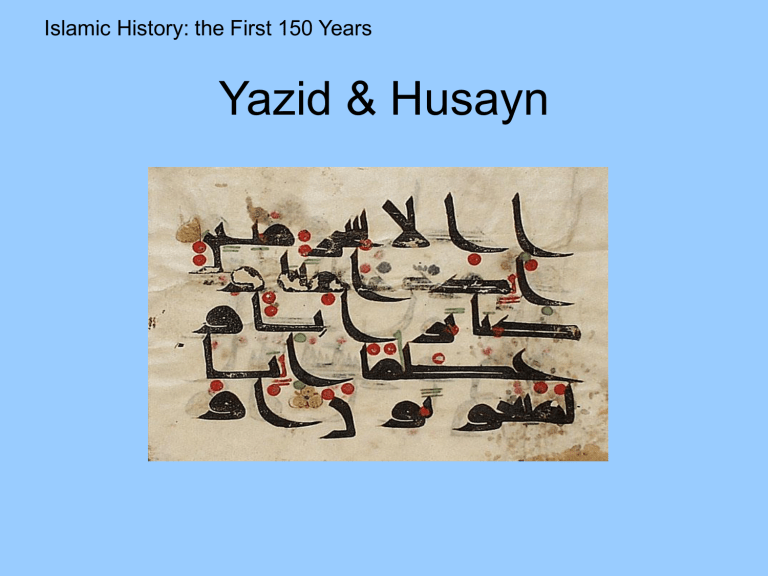
Islamic History: the First 150 Years
Yazid & Husayn
Session Plan
1. Yazid ibn Mu`awiya
2. The Death of Husayn ibn Ali
3. The Death of Yazid
Section I: Yazid ibn Mu`awiya
Introduction
• With Mu`awiya’s death and Yazid’s accession we enter a difficult and complex period of Islamic history
• The sources refer to this period as a ‘fitna’ (as they do for the conflict between Ali and Mu`awiya)
• Fitna translates broadly as ‘sedition’, ‘corruption’, and in this context
‘civil war’
• The Muslim community is thrown into turmoil by this war, which lasts from Yazid’s accession in 680CE through to the death of Abdullah ibn al-Zubayr in 692CE
• This 12 year period is both complex and significant for a number of reasons …
• It is complex because there were at least 3 different factions competing for power (with numerous different leaders)
• It is significant because it sees a number of absolutely crucial developments (religious, political and social)
• Given this, I propose to tackle this period in 2 sessions
• In this session, we will look at the short reign of Yazid
• In the next session, we will focus more closely on events after his death
Yazid’s Background
• As we have seen, Yazid was the son of Mu`awiya
• This makes him a member of the Umayyad clan and thus an extremely wealthy individual
• As I mentioned previously, Yazid is portrayed in the sources as a frivolous, depraved man
• According to our sources, his main ‘hobbies’ (for want of a better term) included listening to dancing girls and playing with his pet monkey
• His is also said to have openly drunk wine during his caliphate
• In other words, our sources (almost entirely) represent him as evil and irreligious
• More seriously, as we shall see, he is also credited with direct and personal responsibility for the murder of Husayn ibn Ali (the grandson of Muhammad)
• When reading accounts of his reign, it is important to bear the bias of our sources in mind
Section II: The Death of Husayn
First Steps to War
• Upon his accession, Yazid wrote to his governor of Medina,
Walid ibn Utba
• He informed Walid of his accession and instructed him compel Husayn, Ibn Umar and Ibn al-Zubayr to pledge allegiance
• Marwan, who was then in Medina, counselled Walid to arrest Husain and Ibn al-Zubayr immediately before news of
Mu`awiya’s death became public
• Walid’s failure to do so allowed both men to escape to
Mecca
• Ibn Umar was not considered a threat, being ‘too religious’
• He seems to have been part of a much wider tendency which attempted to remain neutral
• During the conflict between Ali and Mu`awiya, many others had taken a similar line, such as Abu Musa al-Ash`ari
First Steps to War
• By contrast, Yazid considered Abdullah ibn al-Zubayr to be a very grave threat
• As his name indicates, Ibn al-Zubayr was the son of al-Zubayr ibn
Awwam, a major companion of Muhammad
• Zubayr had died at the Battle of the Camel, fighting against Ali
• Realising that his life was probably in danger, Ibn al-Zubayr fled to
Mecca
• Once there he quickly began to gather support, declaring himself
‘the fugitive at the House’ (or the Ka’ba)
• That he was able to gather such a following indicates that there was discontent amongst the wider Quraysh tribe
• In other words, the predominance of the Bani Umayya had caused many other clans to feel left out
• To this, we must also add the widespread belief (first popularised by Abu Bakr and Umar) that Quraysh in its entirety had a claim to the caliphate
• Umayyad dominance thus threatened that claim
First Steps to War
• Furthermore, Ibn al-Zubayr’s location at Mecca was also important
• As we shall see, during his time in control, Ibn al-Zubayr was able to portray himself as the protector of Mecca
• At any rate, Ibn al-Zubayr was able to defeat the forces of Yazid’s governor
• Unable to defeat him at the outset, Yazid (according to Tabari, from al-Zuhri) sent him a silver chain and manacles (Tab. 2.397)
• This was intended to humiliate him and warn him of future consequences
• Not surprisingly, Ibn al-Zubayr refused to accept this ‘gift’
• Interestingly, he is said to have refused this ‘gift’ at the insistence of Marwan ibn al-Hakam
• Thus, even at this very early stage, we are also dealing with splits in the Umayyad clan itself
• Despite this, Ibn al-Zubayr continued to quietly build up his forces
The Revolt of Husayn
• The account of Husayn’s revolt is given in Tabari (2.227
onwards)
• Interestingly, Tabari’s main source, one `Ammar al-Duhni cites
Abu Ja`far Muhammad ibn Ali ibn al-Husayn
• This man was Husayn’s grandson, was the fifth Imam for the
Shia and was known by the nickname al-Baqir (‘he who splits open knowledge’)
• Meanwhile Husayn, who had also fled to Mecca, had begun to receive letters from his partisans ( shia ) in Kufa, encouraging him to rebel against Yazid
• The first letter was signed by some of the leading supporters of the Alid family in Kufa:
‘We thank God for casting down the tyrannical rule of your enemy, who had usurped the power to rule this community without any right …and killed the best of men [Hujr ibn
Adi] …We invite you to come to Kufa, as we have no Imam to guide us …’ (Tab II, p.223)
The Revolt of Husayn
• A second letter arrived soon afterwards, which counsels speed…
‘In the Name of God, the Merciful, the Compassionate; to al-Husayn ibn Ali, from his shia, the faithful Muslims; further make haste, for the people are awaiting you, as they have no Imam other than you! So haste, and again haste!
Peace’ (Tab. 2. p.234)
• This letter is one of the first references to the Shia by that term
• Husayn’s response important
‘From Husayn ibn Ali to the believers and the Muslims…I have understood what you said and that you have invited me to come to you because you have no Imam to guide you …I am sending you my cousin and the trusted one from my family [Muslim ibn Aqil] to report to me about your affairs. If his report conforms with what you have written, I will soon come. But you must be clear about the fact that the Imam is only one who follows the Book of God, makes justice and honesty his conduct and behaviour, judges with truth, and devotes himself to the service of God.
Peace’ (Tab. 2. p.235)
• This letter reveals a number of significant ideas
• Husayn’s letter does not contain a reference to Shia
• Jafri interprets this as meaning he saw his leadership as wider
The Revolt of Husayn
• An alternative could be that references to a Shia style imamate have been removed
• The letter also reveals that Husayn had reason to doubt the
Kufans’ sincerity
• The final part of the letter sets out a particular idea of the Imamate
• At any rate, Muslim goes to Kufa
• He finds widespread support and writes to Husayn urging him to come quickly
• Although there is widespread support, Ubaydullah ibn Ziyad
(governor of Iraq) has received prior warning of the plan
• And, before he can organise himself properly, Muslim is killed
• However, Husayn has already set off for Kufa
• He is accompanied by his household and retainers
• In other words, he is virtually alone and has no army as such
• Upon reaching Iraq, he is stopped at a place called Karbala by a much larger Umayyad force (reputedly 1,000 strong)
The Martyrdom of Husayn
• The seriousness of the situation seems to have deeply affected everyone present
• Thus, the first Umayyad commander, Hurr al-Tamimi, joined Husayn after a short interval
• He was replaced by Umar ibn Sa’d and all attempts at negotiation ceased
• And, on the evening of 9 th Muharram 61AH (681CE), Husayn prepared for the forthcoming attack
• The sources report a number of speeches, encounters and single combats (as was customary, or at least believed to be)
• Husayn’s last address before the Umayyad soldiers is emotive and because it contains some important ideas, deserves to be quoted
‘O People! You are accusing me but think who I am! Then search your hearts for what you are doing to me. Consider well if it be lawful for you to kill me and violate my sacrosanctity. Am I not the son of the daughter of your
Prophet, the son of the Prophet’s wasi and cousin …? Did not the Prophet say of me and my brother that ‘they are the lords of the youth of Paradise’?
You cannot deny the truth of what I have said concerning the merits of the family of Muhammad.
Are all these not sufficient to prevent you from shedding my blood?’ (Tab. 2. p.329)
The Martyrdom of Husayn
• Husayn’s reference to a statement of the Prophet is interesting and important
• He also refers to the merits of his family, in the same manner as his brother Hasan and father Ali had done previously
• Husayn describes his father as Muhammad’s wasi
• This word basically means ‘heir’ or ‘estate executor’ and is taken by the Shia to be a reference to Ali’s divinely appointed role as Imam
• This is an early reference to what would become a very important
Shia religious concept
• After a short fight, Husayn’s followers are all killed
• His family members then attempt to defend him, but are also killed
• The sources describe the events in great detail and at great length
• However, despite some possible hyperbole, it is clear that most of
Husayn’s family were murdered, including his infant son
• Husayn himself was then killed and his head struck off and taken to
Ubadyullah ibn Ziyad, who gloated over it
The Martyrdom of Husayn
• Ubadyullah ibn Ziyad is reported to have hit the lips of Husayn’s severed head with a cane
• The sources report that Zayd ibn Arqam, an old companion of Muhammad, saw this:
‘Remove your cane from those lips! By God, on these lips have I seen the lips of the Prophet of God
…’ (Tab. 2., p.373)
• Ali ibn al-Husayn, Husayn’s ill teenage son was the only male survivor of the massacre
• The women of Husayn’s family, along with the corpses were then taken to
Yazid in Damascus
• In purely physical terms, Karbala proved a disaster for the Ahl al-Bayt in that most of its adult males were murdered
• As you might expect, the event had a profound impact on Ali ibn al-Husayn
• Ali was a deeply religious man and after being returned to Medina by Yazid, he eschewed all involvement in politics
• He has the reputation of a very devout man and a number of his prayers have been recorded
• Because of this reputation, he is more widely by the honorific title Zayn al-
`Abideen (‘Ornament of the Worshippers’)
The Martyrdom of Husayn
• Tabari’s account is long and detailed, illustrating the event’s significance
• The revolt and death of Husayn mark a turning point in Islamic history
• The murder of Husayn and almost his entire family sent shockwaves throughout the Muslim empire
• For the Shia, his death is seen as willing martyrdom for the cause of
God
• And, very quickly afterwards, the Shia community began to mark the day (10 th Muharram)
• Later on, this developed into a series of elaborate re-enactments and displays of ritual grief and is now the most important Shia religious ceremony
• Ubaydullah followed this with a series of arrests of key Shia supporters
• And, at that point, the revolt seemed to be over
• However, as we shall see in the next session, this was not the case
Questions?
Section III: The Death of Yazid
Crisis & revolt
• The fall of Husayn and the subsequent repression allow Ibn al-Zubayr to strengthen his hand
• He begins to take pledges of allegiance in secret
• In 63AH, a deputy of senior figures from Medina visits Yazid to put rumours of his drunkenness to the test
• Upon their return, Medina renounces its loyalty to Yazid and revolts
• Marwan ibn al-Hakam and about 1,000 clansmen and retainers are besieged in their homes
• Marwan writes to Yazid for reinforcements
• Muslim ibn Uqbah al-Murri (a staunch supporter of Yazid) crushes the revolt, ransacking Medina in the process
• Interestingly, Zayn al-`Abideen takes no part in the revolt
• At about this time, Ibn al-Zubayr openly revolts
• The Umayyad force, now under a different commander, laid siege to Mecca
The Siege of Mecca
• During this period, Mecca was twice besieged
• Both sieges saw the use of heavy catapults and fire
• Indeed, the Ka’ba itself seems to have been damaged in the fighting
• The first siege ended in 64AH (683CE) with the sudden death of Yazid
• The Umayyad force then began to negotiate with
Ibn al-Zubayr (who was now the only predominant force)
• With the Umayyads in disarray, Ibn al-Zubayr is recognised as caliph in Mecca, Medina, Arabia and parts of Syria
• He is also able to appoint his brother, Mus`ab, as governor of Iraq
Umayyad Collapse?
• Yazid’s son Mu`awiya (known as Mu`awiya II) is appointed caliph in Syria by the Umayyad forces there
• However, with Yazid’s death, the Umayyad camp itself split into several factions
• Mu`awiya II lasts barely a few months before being killed
• Marwan thus emerged as the clear Umayyad candidate and was declared caliph in 64AH (684CE)
• This change of dynasty was to have momentous consequences
• Mu`awiya’s direct descendents (known as the Sufyanids after Abu Sufyan) lost their claim to the caliphate
• The Marwanid dynasty provided the caliphs for the next 70 years
• And, at the Battle of Marj Rahit, Marwan defeats the
Zubayrid forces decisively, forcing a retreat to Mecca
• This change of dynasty marks a convenient place to stop and pause for a moment
